Infrastructure for Software Services: Understanding Cloud Service Models and Cloud Computing Deployment Models
Blog / Infrastructure for Software Services: Understanding Cloud Service Models and Cloud Computing Deployment Models
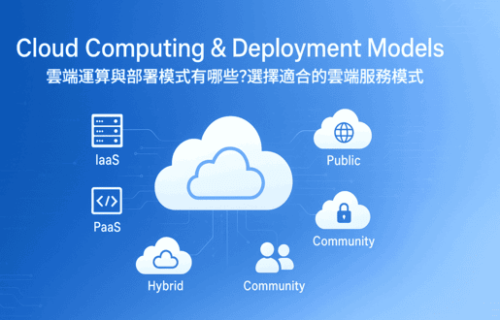
Digital transformation has become a critical factor in enhancing corporate competitiveness in today’s world. How can businesses leverage the right and efficient cloud deployment models to adapt to market changes?
First, it is essential to understand the various cloud service models and the differences in cloud computing architectures. By planning a suitable framework tailored to the organization’s specific needs, businesses can maximize the benefits. OneAsia will guide you through the distinctions and practical applications of these cloud computing deployment models.
Three Major Cloud Service Models: IaaS, PaaS, SaaS
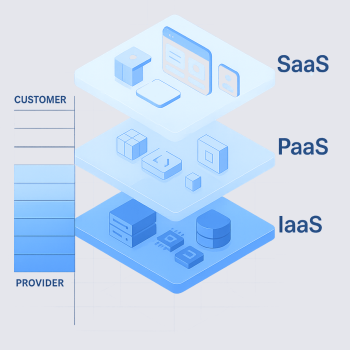
IaaS(Infrastructure as a Service)
IaaS primarily provides customers with virtualized computing resources, such as virtual machines (VMs), virtual disks, cloud storage, virtual networks, and firewalls. Users can leverage this cloud service model to build or protect their data. Common applications include renting virtual servers in the cloud for website hosting and system testing. IaaS offers highly flexible storage capacity and system control permissions. Tenants can dynamically adjust their resource allocations to match evolving usage demands.
PaaS(Platform as a Service)
PaaS represents a service mechanism where the platform itself is delivered as a service, providing users with a complete cloud service model. Supported components typically include cloud computing power, server operations, database management systems, and application development tools, enabling developers to focus on the development process and application deployment. This cloud computing model eliminates the need for underlying infrastructure construction or self-hosted servers. Developers can instantly integrate with their company’s cloud deployment model (public, private, or hybrid cloud) on the provided online platform to manage critical data, perform software development, and execute data transfers.
SaaS(Software as a Service)
SaaS, as the name implies, allows users to operate applications via a browser or downloaded software without needing to build servers, implement technical infrastructure, or maintain operating systems. Service providers handle server management, system updates, and related tasks. SaaS also supports cross-device synchronization. Users simply download the same software on different devices and log in to their account to enable data sharing and seamless workflow continuity, regardless of location or time.
Which Cloud Service Model Suits You Best? A Comparison of Three Service Models
After understanding the three cloud service models, how do enterprises determine which one is suitable for their business? Each model varies in deployment based on enterprise needs. Below are the three cloud service models and their applicable scenarios.
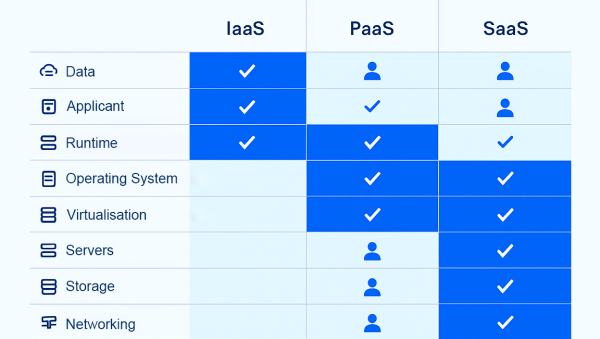
IaaS Use Cases and Advantages
IaaS has higher technical requirements compared to the other two models, typically requiring specialized technicians to assist with operating system installation, system application deployment, and network configuration. However, IaaS offers users high flexibility, including various virtualized resources (VMs, servers, cloud storage). This allows users to dynamically adjust resource leasing based on their own usage needs, to realize a pay-as-you-go model.
This cloud service model also offers rapid deployment and global scalability, enabling swift provisioning of resources based on business needs. Service providers leverage globally located data centers to deploy systems according to target market locations or optimize cloud deployment models by analyzing end-user geographic distribution and usage patterns, thereby enhancing customer experience. IaaS is suitable not only for SMEs and startups but also for growing enterprises and multinational corporations.
PaaS Use Cases and Advantages
Since PaaS requires no self-built development platforms, nor underlying server management or network configuration, it can save startups significant time and technical resources that would otherwise be spent on building infrastructure. This accelerates development progress and avoids the need for large technical teams for backend maintenance. For instance, this cloud service model is frequently used in online learning platforms, allowing teams to focus on course design, content creation, and service delivery.
SaaS Use Cases and Advantages
SaaS also has the advantages of no installation or system setup required, making it ideal for remote work or multinational teams. Users simply need internet access and can start using the service by clicking to log in to the software. This cloud-based system deployment model is widely used for applications like Customer Relationship Management (CRM), customer service systems, or cloud file storage systems such as Dropbox. It enables greater efficiency in internal collaboration, project management, and document sharing within enterprises. Furthermore, this cloud service model is highly suitable for real-time online meetings during work. Common meeting platforms like Google Meet and Microsoft Teams support instant voice and video conferencing, enhancing communication efficiency for remote workers and accelerating workflow processes.
Comparison Table of Three Cloud Service Models
| IaaS | PaaS | SaaS | |
|---|---|---|---|
| Scope of Services | Virtual machines, cloud storage | API, platform development, database | Applications (CRM, ERP) |
| Target Users | IT personnel, system administrators | Developers, engineering teams | General users, business professionals |
| Advantages | Highly flexible and customizable | Rapid development, maintenance-fee servers | Quick setup, no technical background required |
What Are the Cloud Computing Deployment Models?
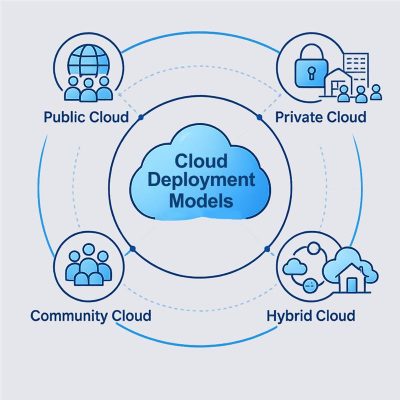
Unlike cloud services, which primarily concern the level and form of service content, cloud computing’s “deployment models” focus on data access methods, security, as well as the construction and usage types of cloud environments. Selecting the appropriate model is the primary factor in planning an enterprise’s digital transformation. Different models each possess unique characteristics and advantages. Below are explanations of several common cloud computing deployment models and solutions:
Public Cloud
This model relies on third-party providers, so enterprises do not need their own data centers to manage data. It suits companies seeking high flexibility and scalability. Well-known examples like Google Cloud, AWS, and Microsoft Azure fall under this cloud computing deployment model.
Private Cloud
Resources are not shared with any external parties. Typically deployed within the enterprise’s own premises for data access and storage, it offers higher security and controllability. Commonly adopted in the healthcare industry or by organizations with stringent requirements for personal or user privacy data.
Hybrid Cloud
It combines elements of both public cloud and private cloud. Enterprises can configure it according to their needs, keeping sensitive and private data within the private cloud for enhanced security. Meanwhile, data intended for user sharing or API integration can reside in the public cloud, enabling convenient access and connection to databases and various library resources. Hybrid clouds offer flexibility in data management while ensuring the security of private data.
Community Cloud
Community Cloud is a deployment model suitable for organizations with shared requirements to jointly own and manage resources. Data within this kind of cloud is restricted to members of the community through permissions.
Cloud Computing Deployment Models and Colocation: OneAsia is Your Top Choice
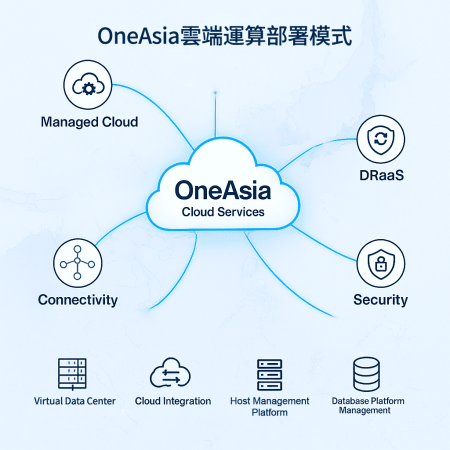
The difference in cloud computing models is determined by who manages which aspects, which elements require technical support, and which require maintenance by the enterprise itself. To address the diverse scenarios and applicability of the aforementioned cloud deployment models, OneAsia offers a comprehensive cloud service offering, including one-stop cloud service hosting, professional technical support teams, and network connectivity services. Regarding information security, we adhere to international information security standards, deploy intrusion detection systems, and conduct regular security audits to safeguard the privacy and confidentiality of client data.
OneAsia’s IaaS cloud service model saves business from the expense of building its own server room and expensive hardware resources, with services that include:
- Virtual Data Center: Provides enterprises with high autonomy to manage virtual machines (VMs), along with subscription services for data storage space, network resource allocation, and other resources required by the enterprise.
- Highly elastic computing resources: Scalable to accommodate business growth, users need not worry about resource shortages or limitations arising from business expansion or increased user numbers.
- Data Center Colocation and Cloud Integration: With robust information security protection and centralized data center hosting, users can easily and quickly access and categorize data. Cloud integration combines multiple cloud deployment models, enabling the IaaS architecture to achieve flexible hybrid cloud environments.
In addition, OneAsia also provides a range of platform-level technical services to help organizations save manpower for cloud computing deployment during the development process, streamline IT operations, and focus on delivering value-added services and driving innovation. In terms of PaaS, OneAsia offers:
- Server Management Platform: Enables users to install application servers such as Web Servers or Database Servers, supporting rapid deployment of cloud computing models tailored to your enterprise needs.
- Database Platform Management: Highly secure database management delivering robust data protection measures, ideal for enterprises or government agencies with specific data management requirements. Enhances efficient public services and shared services while offering flexible scalability and stringent access control mechanisms.
If you have questions or requirements regarding cloud service models or other enterprise cloud deployments, contact OneAsia to learn more about our services. We tailor solutions to your specific needs, helping you advance toward smart operations and enterprise digital transformation. We also assist in effectively managing IT resources while integrating with existing infrastructure for cost optimization.
References:
https://www.techtarget.com/searchcloudcomputing/definition/Software-as-a-Service
https://azure.microsoft.com/en-us/resources/cloud-computing-dictionary/what-is-saas
https://www.techtarget.com/searchcloudcomputing/definition/Platform-as-a-Service-PaaS
https://www.proofpoint.com/us/threat-reference/infrastructure-as-a-service-iaas
https://www.ibm.com/cn-zh/think/topics/iaas-paas-saas


